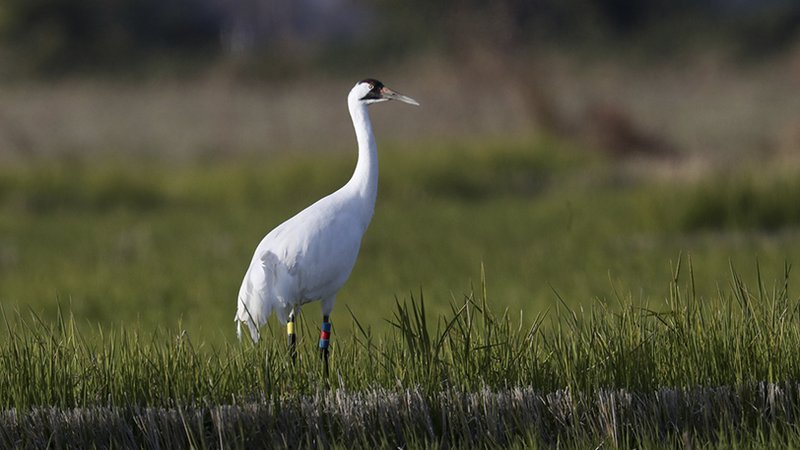Louisiana-released whooping crane enjoys layover in The Natural State
ON 01-09-2019

Jan. 9, 2019
Randy Zellers
Assistant Chief of Communications
STUTTGART — A rare visitor from the coastal marshes took an extended break in Arkansas during the first two segments of duck season this year. A whooping crane, one of the most recognized birds listed on the federal list of endangered species, spent the last three months bouncing around east Arkansas, primarily in fields between Roe and Aberdeen in western Monroe County.
The female crane, labeled L4-17, has been a bit of a nomad during the last year, spending time in Louisiana, Alabama, Mexico and Oklahoma before settling into Arkansas last October.
According to dates provided by LDWF, the crane was first located by transmitter in Arkansas near Hartman on October 5. She then hopped around, being seen near Lake Dardanelle and the shore of Lake Atkins before settling in at a rice field between Roe and Aberdeen in Monroe County from mid October until mid-December.
“Initially the crane’s location was kept fairly quiet among birders, and was only reported on an email group coordinated by the Arkansas Audubon Society,” said Karen Rowe, the Arkansas Game and Fish Commission’s nongame migratory bird program coordinator. “The AGFC has been monitoring her throughout fall and keeping a close eye on her, because she decided to stay extremely close to an intersection between two highways and was very visible.”
Rowe said biologists feared the crane may become stressed or pushed out of the area prematurely from birdwatching pressure, but hunters and landowners in the Aberdeen/Roe area called with concerns about the crane falling victim to an illegal shooter. They asked AGFC to give the location of the whooping crane to Arkansas birders, hoping an influx of birders with their binoculars, spotting scopes and cameras would help keep the crane safe.
“Having observed her behavior, I felt that their suggestion was best for both the crane and the birdwatchers,” Rowe said.
Dr. Mahlon Maris of Roc Roe Hunting Club was one of the conservation-minded hunters who did everything he could to keep the bird safe during her stay.
“We’d heard rumors that the crane was around, and one member who is an avid birder said he’d seen it,” Maris said. “When the area’s caretaker said he saw a huge wood stork with a black head, I told him about the crane and told him to let folks know that they could get in serious trouble if they messed with it. She stayed on one 40-acre field for nearly two months, eating frogs, fish and wild squash.”
The crane is part of a reintroduction effort between the Louisiana Department of Wildlife and Fisheries, the U.S. Fish and Wildlife Service, the U.S. Geological Survey, the International Crane Foundation and the Louisiana Cooperative Fish and Wildlife Research Unit. Whooping cranes were transported to the coastal marsh of Vermillion Parish from a captive flock at the USGS Patuxent Wildlife Research Center in Laurel, Maryland beginning in 2011.
Rowe says many reports continued to come in from hunters as well as birders who saw the crane. She even heard reports of hunters stopping to ask some birders if they could look at the crane through their spotting scope to enjoy the once-in-a-lifetime experience.
“This rare wandering crane did so much for avian conservation in Arkansas,” said Rowe. “It broke down barriers and showed that all who watched and admired her were simply conservationists and not labeled as hunters or birders. It did my heart good to sit there on the highway and watch everyone who came to see her get excited about her presence.”
Rowe says members of Roc Roe Hunting Club gave regular posts about the crane, which they dubbed, “Edna.”
“That was the most rewarding thing to me,” Rowe said. “To see everyone take such pride in the bird’s presence.”
In mid-December L4-17 began getting restless again, moving to a spot just east of George H. Dunklin Bayou Meto Wildlife Management Area at Lodge’s Corner. She then moved to nearby Hampton’s Reservoir and flew to an area known as Brewer Bottoms. Just after Christmas, the crane left Arkansas and travelled all the way to Wheeler National Wildlife Refuge in north Alabama, a popular wintering location for sandhill cranes. The refuge also is a temporary home for a small group of whooping cranes that are part of a separate reintroduction of an eastern migratory flock. L4-17 arrived to join a dozen other whooping cranes and roughly 10,000 sandhill cranes currently at the refuge.
Whooping cranes, the most endangered of all of the world’s crane species, were first added to the federal status of an endangered species on March 11, 1967. According to the International Crane Foundation, only about 1,200 to 1,500 whooping cranes were left in North America in the mid-1800s. The species was nearly wiped out from conversion of nesting habitat to agricultural acreage and overharvest. By the late 1930s, only two small flocks were left — one non-migratory flock in Louisiana and one migratory flock that wintered in Texas and summered in Canada. A hurricane in 1940 reduced Louisiana’s flock to a mere 21 birds, which eventually withered until the last wild bird was brought into captivity for protection of the species in 1950.
Recent News
Subscribe to Our Weekly Newsletter E-mails
Don’t miss another issue. Sign up now to receive the AGFC Wildlife Weekly Newsletter in your mailbox every Wednesday afternoon (Waterfowl Reports are published weekly during waterfowl season and periodically outside the season). Fishing Reports arrive on Thursdays. Fill in the following fields and hit submit. Thanks, and welcome!


